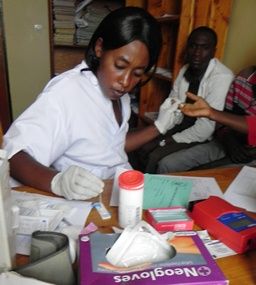Epidemiology &Malaria in Pregnancy Bill Brieger | 25 Oct 2015 09:07 pm
Prevalence and Factors Associated with Malaria in Pregnancy in Rural Rwandan Health Facilities: A Cross-sectional Study
Colleagues[1] from the Rwanda Ministry of Health, Jhpiego and the Johns Hopkins Bloomberg School of public Health are presenting a poster at the 64th ASTMH Annual Meeting in Philadelphia at noon on Monday 26th October 2015. Please stop by Poster 315 and discuss the results as presented in the Abstract below.
Malaria in pregnancy (MIP) is a serious health risk for the pregnant woman and fetus and associated  with mortality in the perinatal period. In Rwanda there has been no accurate national estimate of malaria prevalence among pregnant women. In 2011, a cross-sectional study of 6 districts in 3 malaria transmission zones (low, medium and high) in Rwanda was conducted to estimate the prevalence of peripheral parasitemia in pregnant women. Data were collected from consenting women presenting to antenatal clinics (ANC) for the first time in their current pregnancy including age, parity, gestation, ITN availability and use.
with mortality in the perinatal period. In Rwanda there has been no accurate national estimate of malaria prevalence among pregnant women. In 2011, a cross-sectional study of 6 districts in 3 malaria transmission zones (low, medium and high) in Rwanda was conducted to estimate the prevalence of peripheral parasitemia in pregnant women. Data were collected from consenting women presenting to antenatal clinics (ANC) for the first time in their current pregnancy including age, parity, gestation, ITN availability and use.
Blood was obtained for malaria testing using microscopy, rapid diagnosis tests and polymerase chain reaction (PCR). A total of 4,037 pregnant women were recruited with median age of 27 years, and 3,781 (93.7%) had usable PCR samples. The prevalence of MIP by PCR was 5.6%.
 Nearly 20% of women’s families did not have a net, and 8.7% of these tested positive compared to 4.9% of women whose family owned an ITN. For those who did not sleep under an ITN the previous night, 8.1% tested positive compared with 4.8% who slept under an ITN. Malaria prevalence by parity ranged from 5.5% (parity 0-1), to 5.4% (parity 2-3), and 6.5% (parity 4 or more). The two districts that bordered highly endemic countries had MIP prevalence rates of 10% and above. Those testing positive were treated according to national guidelines.
Nearly 20% of women’s families did not have a net, and 8.7% of these tested positive compared to 4.9% of women whose family owned an ITN. For those who did not sleep under an ITN the previous night, 8.1% tested positive compared with 4.8% who slept under an ITN. Malaria prevalence by parity ranged from 5.5% (parity 0-1), to 5.4% (parity 2-3), and 6.5% (parity 4 or more). The two districts that bordered highly endemic countries had MIP prevalence rates of 10% and above. Those testing positive were treated according to national guidelines.
Despite a significant decline of 86% in malaria prevalence in the general population from 2005 to 2011, MIP prevalence remains high, especially in border districts. Our study also showed that ITN ownership and use among these pregnant women is below the national target. In order to address this gap, ITN distribution to achieve universal access, and educational campaign targeted at pregnant women on the use of ITN are recommended. Furthermore, early detection and treatment of MIP at ANC and regional collaboration to reduce cross-border malaria transmission should be prioritized.
general population from 2005 to 2011, MIP prevalence remains high, especially in border districts. Our study also showed that ITN ownership and use among these pregnant women is below the national target. In order to address this gap, ITN distribution to achieve universal access, and educational campaign targeted at pregnant women on the use of ITN are recommended. Furthermore, early detection and treatment of MIP at ANC and regional collaboration to reduce cross-border malaria transmission should be prioritized.
————————–
[1] Corine Karema, William R. Brieger, Irenee Umulisa, Aline Uwimana, Jeremie Zoungrana, Beata Mukarugwiro, Rachel Favero, Elaine Roman, Barbara Rawlins, Tharcisse Munyaneza, Fidele Ngabo, David Sullivan, Jean Baptiste Mazarati, Rukundo Alphonse, Agnes Binagwaho